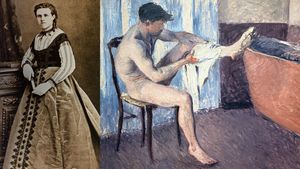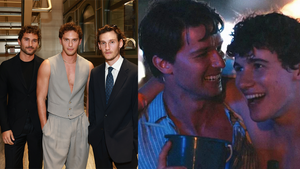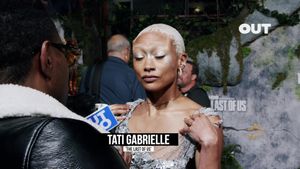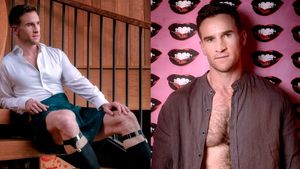Victor Gadino's commercial and fine artwork is exquisitely rendered, formally composed on classic lines, and breathtakingly sexy. It's a small wonder that his groundbreaking book cover illustrations worked hand in hand with Gordon Merrick's equally groundbreaking gay romance novels to make a seismic shift in the mainstreaming of gay content. These paperbacks sold in supermarkets! If you are a gay man of a certain age, you will most likely recall seeing them everywhere -- especially The Lord Won't Mind (a title for the ages, in this period of the Christian right's aggressive campaign to deny LGBT people their equal rights and even deny their existence). Gadino continues to work in New York creating art for books, film, and ad campaigns as well as creating fine artwork on his own. He also creates amazing portraits and sells giclee reproductions of his work. See the bottom of the page for contact info and see page 18, Wessley, for an example of one of his custom portraits.
The Advocate: Why are you an artist?
Victor Gadino: Actually, I didn't choose it ... it chose me. My earliest memories are of holding a crayon or pencil and drawing. I was 3 or 4. Where does that come from? Who knows? Some people have told me I'm channeling spirits, and it really does feel that way sometimes. Although I was an art major in college and received an MFA from Pratt, most of what I leaned was self-taught. My professors were afraid to talk to me about all the homoerotic images I was creating, and so they just left me alone to draw and paint, but then almost canceled my thesis show because of the realistically rendered graphic subject matter. Luckily, an open-minded faculty member fought for me and the show opened uncensored.
What catches your eye?
Extreme beauty that verges on the grotesque.
Tell us about your process or techniques.
Being an artist is so at the core of what I am. It's all I've ever known or been. I've never had a job outside of my commercial illustration work. It's like therapy for me. It's how I cope with feelings and emotions as I try to navigate through life and its mysteries. I use mythology, religion, and the human form to explore the physical world and answer my questions of what might lie beyond it.
Although my work resembles academic realism -- I love most of the Victorian painters -- I do not use traditional techniques. For example, I usually paint from top to bottom and left to right. There is no under-painting. The finished piece is totally completed in my head before I even start. It just need to get it out of me.This is when I go into an almost trancelike state where I totally lose track of time and forget to eat or drink. Sometimes the day flies by and I don't realize it until the brush falls out of my hand because it's gotten so stiff. But I'm not aware of any pain ... that is, until I stop. I don't recommend it.
How do you choose your subjects?
Mostly I feel some kind of connection or attraction to an individual. It starts out visually but then goes deeper. It's a challenge because many people think you are hitting on them if you ask them to come to your studio to pose. Unfortunately, I've had to pass on a lot of extremely interesting strangers I see on the street or subway, potential models who might look at you funny or sock you in the jaw if approached them. And then there are some people who show up and can't wait to get out of their clothes. It's like they expect sex to be part of the unique artist-model relationship. And sometimes I feel obliged to comply.
On getting the Gordon Merrick cover assignments?
I was very young and just starting out as an illustrator to make money. In those days you could make appointments with the art directors of the various publishing houses and walk in lugging a big heavy portfolio of original paintings and printed covers. Avon books decided to rerelease the Merrick novels as typical mass market romance paperbacks. Up until then they had simple covers and were sold in specialty shops or from "under" the counter. The head art director was a strong female with vision and a great eye. It was the early days of gay liberation and she recognized the time was right. She saw my talent and gay sensibility and gave me the assignment for the first cover, the most conservative one, An Idol for Others. I never met Mr. Merrick, but I was told he was not happy with the mature model I used and thought he looked too old. He was, however, very pleased with the eight covers that followed, all using handsome young models. I made sure to clear the gay issue with the modeling agencies before I booked the models. The guys that were comfortable with their sexuality, be it straight or gay, were fine posing. And those that were homophobic refused.
With each assignment I was given the book to read and the suggestion of a scene to illustrate. They were extremely sexually graphic for their time. Now that we are so desensitized by reality TV, I'm sure they seem tame. But they were are full of gorgeous muscle numbers, beautiful exotic locations, and they were well written. And I guess Avon Books was right about the timing. The books were so popular, men from all over the country wrote me fan mail about how much the books and the covers meant to them, helped them come out or cope with being gay. The one I wish I had saved was a glowing letter of appreciation from a Catholic archbishop! Go figure.
Was it risky in those years for my career doing male-oriented art ?
I 'm sure I missed out on some jobs for Good Housekeeping or Woman's Day, but I never felt that my male-oriented art limited me or held me back in illustration. Unfortunately, today there is still resistance to accepting the male nude as fine art in the museum and gallery scene. That I'm still waiting on to change.
Artist Bio:
Victor Gadino is an award-winning artist who holds an MFA from Pratt Institute. His work has promoted top clients in the corporate, publishing, and entertainment worlds, such as Sony, Seagram's, R.J. Reynolds, American Express, General Foods, Playboy, Hearst, Random House, Harper Collins, NBC, Time Warner, Paramount, United Artists, MGM, Lucasfilm, Disney, and Universal, to name a few.
Awards received include one from The Hollywood Reporter for his work on prominent movie posters. He received the second place drawing award in the Art Renewal Center's 2009 Annual International Competition. He has created album covers for various artists, posters for Broadway plays, and collectibles for the Bradford Exchange and Franklin Mint.
His work has been featured in publications including Communication Arts Illustration Annual 50, for which he won an Award of Excellence, Society of Illustrators Annual 43, Direct Art Magazine Volume 14, Aphrodisia II--The Art of the Female Form, Treasures From the Permanent Collection of the Leslie Lohman Foundation (All Saints Press), Powerfully Beautiful (Firehouse Studio Publications), and Dirty Little Drawings and Stripped, published by Bruno Gmunder.
He accepts portrait commissions, and his work can be found in the collections of George Lucas, Clint Eastwood, Alan Alda, Mr. and Mrs. Andrew Tisch, Mr. and Mrs. Henry Kravis, and other prominent New York City families.
About Gordon Merrick:
If Barbara Cartland and Jacqueline Susann had a gay love child, it would be Gordon Merrick. His life -- privileged upbringing, Princeton, Broadway actor, journalist, counterespionage officer, and finally world-renowned author of the first gay romances -- was like that of one of his characters.
As a young, wealthy, and unbelievably gorgeous young man, Merrick dropped out of Princeton from boredom and hit Broadway to become an actor. After getting roles in top Broadway hits (The Man Who Came to Dinner) he quit ... from boredom. It was too repetitive.
He wrote his first best seller, Strumpet Wind, which contained some references to homosexuality, and this gave him the seed money to start writing his more directly gay romance novels. It also allowed him to live all over the world: Mexico, the island of Hydra in Greece, and finally, Sri Lanka.
The book he is best known for, The Lord Won't Mind, sat on the New York Times best-seller list for 16 weeks -- in 1970! The first in a trilogy, Merrick followed it up with One for the Gods in 1971 and Forth Into Light in 1974. His style is overblown and dramatically romantic. His continuing characters -- Charlie and Peter -- are both exquisitely good-looking, perfectly muscular, and enormously endowed. And blond. And rich.
Merrick broke new ground with these books. These were not the tortured, gay-man-dies-for-his-sins books of the 1950s. These men had rampant sex and these books had happy endings -- but not without operatic turmoil first. And then there were the covers painted by Victor Gadino. There was nothing coy or shady about these covers -- they matched the current vogue in paperback covers for other romance novels, pout for pout, but they featured a male couple.
Merrick's writing was criticized as shallow and looks-obsessed. He defended his writing by saying that the desire for male beauty was a core value in being a gay man. But looking critically at his work is missing the point. His books are deliriously fun and deeply campy -- the way only things that take themselves too seriously can be. If you scour the used-book stalls you may find some of the reissues Alyson Books came out with in the 1990s.


















































































Fans thirsting over Chris Colfer's sexy new muscles for Coachella